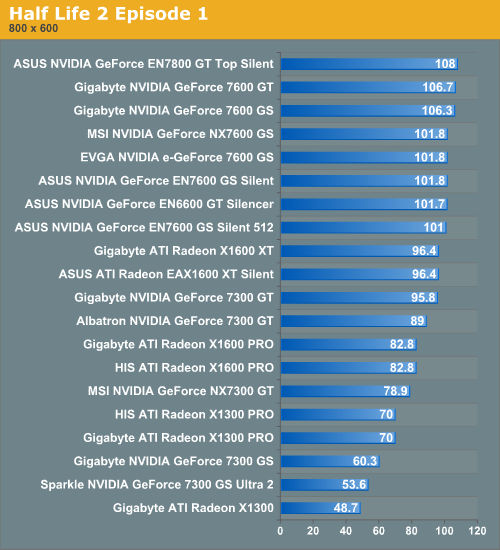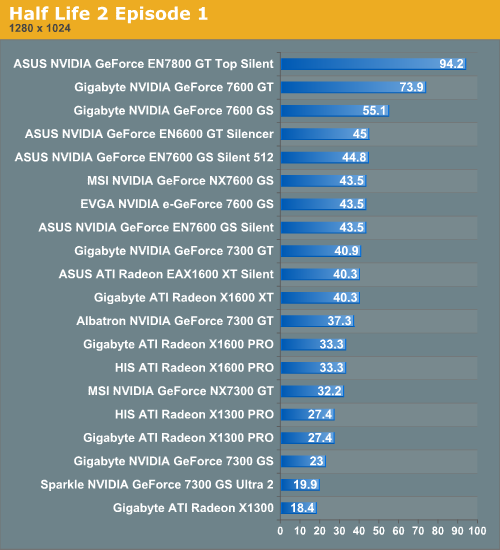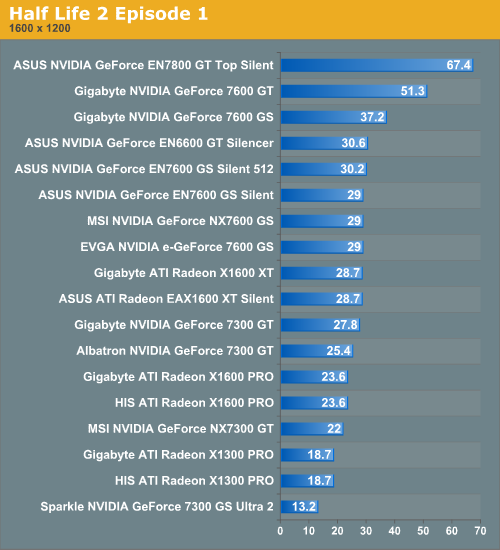Half-Life 2: Episode One
Half-Life 2 has been on our list of games for benchmarking for a long time, and what is great about Valve is that they are continually updating this game, not only in new story content but also graphical content. Half-Life 2: Episode One utilizes newer HDR (High Dynamic Range) lighting effects to give the HL2 engine a new look. The new effects add greatly to the aesthetics of the game, but in addition to this they also add to the game's performance demands. This is a trend in gaming: as games get prettier, faster hardware is required to run them well. Valve has been good about keeping their performance requirements lower than most games of this type however, and that's one of the reasons Half-Life 2 and Half-Life 2: Episode One have been so successful. (The fact that the games are very enjoyable to play also helps, of course.)
We set the detail settings to "high" in the graphics settings for this game. Water detail is set to "Reflect All," and High Dynamic Range is set to "Full (if available)."




The Gigabyte 7300 GT outperforms the other 7300 GT cards and manages to get framerates closer to the 7600 GS, as we mentioned earlier. The Albatron 7300 GT gets similarly high performance, and only at the highest resolutions do we see a big drop in framerates with these two parts.
The Gigabyte 7600 GS and GT handle 1600x1200 with ease, and most of these cards get playable framerates up to 1280x1024 resolution. Because the action in games like this one is so fast-paced, those with an X1600 XT or 7300 GT might prefer the smoother gameplay they would see at 1280x1024 rather than 1600x1200. (This is assuming the cards are even connected to a display that can handle higher resolutions, which often isn't the case.)
It's also nice that this game can be enjoyed by those with even the slowest cards in our tests (the Gigabyte X1300 and Sparkle 7300 GS Ultra 2) at 1024x768 or 800x600. These resolutions will still provide enjoyable gameplay, especially with all the HDR and water detail effects enabled.
Half-Life 2 has been on our list of games for benchmarking for a long time, and what is great about Valve is that they are continually updating this game, not only in new story content but also graphical content. Half-Life 2: Episode One utilizes newer HDR (High Dynamic Range) lighting effects to give the HL2 engine a new look. The new effects add greatly to the aesthetics of the game, but in addition to this they also add to the game's performance demands. This is a trend in gaming: as games get prettier, faster hardware is required to run them well. Valve has been good about keeping their performance requirements lower than most games of this type however, and that's one of the reasons Half-Life 2 and Half-Life 2: Episode One have been so successful. (The fact that the games are very enjoyable to play also helps, of course.)
We set the detail settings to "high" in the graphics settings for this game. Water detail is set to "Reflect All," and High Dynamic Range is set to "Full (if available)."




The Gigabyte 7300 GT outperforms the other 7300 GT cards and manages to get framerates closer to the 7600 GS, as we mentioned earlier. The Albatron 7300 GT gets similarly high performance, and only at the highest resolutions do we see a big drop in framerates with these two parts.
The Gigabyte 7600 GS and GT handle 1600x1200 with ease, and most of these cards get playable framerates up to 1280x1024 resolution. Because the action in games like this one is so fast-paced, those with an X1600 XT or 7300 GT might prefer the smoother gameplay they would see at 1280x1024 rather than 1600x1200. (This is assuming the cards are even connected to a display that can handle higher resolutions, which often isn't the case.)
It's also nice that this game can be enjoyed by those with even the slowest cards in our tests (the Gigabyte X1300 and Sparkle 7300 GS Ultra 2) at 1024x768 or 800x600. These resolutions will still provide enjoyable gameplay, especially with all the HDR and water detail effects enabled.










49 Comments
View All Comments
imaheadcase - Thursday, August 31, 2006 - link
I guess to each his own, i play bf2 on a 19inch CRT monitor at 1024x768. But even if i had a better card i would still prefer lower rez.DerekWilson - Thursday, August 31, 2006 - link
it's an issue of how games work on the inside ...all the objects, shapes, characters, and landscapes are there no matter how you see them. everything is mathematically represented in the software. rendered onto your display is a viewport into the world. this viewport only allows you to see a fixed grid of colors. the color of each pixel is determined by a bunch of factors, but the largest contribution is made by the object that projects onto a particular pixel.
... on second thought, this is too hard for me to explain with out a lot of math. lets look at it another way.
when there's a naked person on tv, they decrease the resolution of the area over the persons naughty bits. this makes it harder to see what's really there because there is a smaller number of large pixels that can only represent one color each. it follows, then, that it would also be harder to shoot the person acurately in said bits.
I think your preference may be based on your experience with performance at higher resolutions. Responsiveness is necessary for a quality experience in games like bf2. If you get a faster card, I would encourage you to at least try a higher resolution.
blckgrffn - Thursday, August 31, 2006 - link
When it is in stock at newegg, its ~$90, not nearly $140.Nat
mostlyprudent - Thursday, August 31, 2006 - link
I would be interested to know how much noise (quantitatively) an actively cooled 7600GS or 7600GT contributes to a system built in a relatively quiet case like an Antec P150. I am familiar with some of the leaf blowers attached to the higher end cards, but wonder how much overall system noise savings you'ld get in the mid-range cards.wilburpan - Thursday, August 31, 2006 - link
One obvious use for silent video cards would be in an HTPC system, where quiet performance would be a priority. Can't have those noisy computer fans intrude on watching Snakes on a Plane, you know. :@) Anyway, it would have been nice to include some video playback benchmarks to see how these cards can handle playing back a 1080p HDTV signal, or similiar tests.ViRGE - Thursday, August 31, 2006 - link
Since HDTV is MPEG2, any modern video card should be able to handle a 1080P signal(since this is an either/or case, it either can or can't). The limitations come in to H.264, where the video decode engine may not be clocked high enough to do higher resolution decoding. Unfortunately, I'm not sure there's any 1080 commerical/usable content that would work with Cyberlink/Intervideo's H.264 decoders(the only ones with GPU acceleration), since Quicktime content doesn't work in those.DerekWilson - Thursday, August 31, 2006 - link
with nvidia, the video decode engine is clocked off the core -- it actually will run better on a card with fewer pipelines and a higher core speed ... iow, the 7600gt is a better video decode graphics card than a 7900gt at default clock speeds.a little counter intuitive, but there it is.
nvidia 7 series parts with a core clock of >450 MHz should have no problem accelerating 1080p decode on players that support purevideo.
MontagGG - Thursday, August 31, 2006 - link
Which of these have HDCP?DerekWilson - Thursday, August 31, 2006 - link
to my knowledge, none of the cards tested here support hdcp. but I will certainly try to confirm this ...